143 posts
Latest Posts by astrosciencechick - Page 4

NGC 2736: The Pencil Nebula
Image Credit: Howard Hedlund & Dave Jurasevich, Las Campanas Obs.
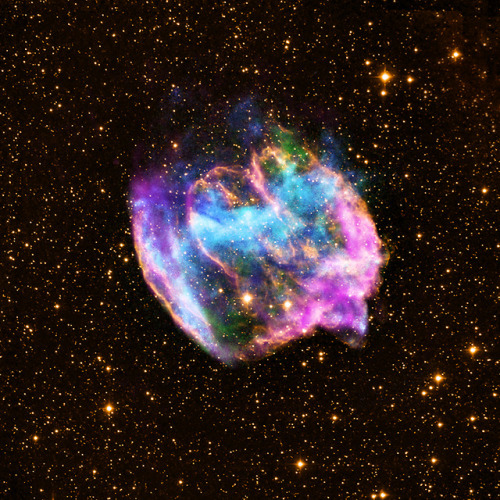
The highly distorted supernova remnant shown in this image may contain the most recent black hole formed in the Milky Way galaxy. The image combines X-rays from NASA’s Chandra X-ray Observatory in blue and green, radio data from the NSF’s Very Large Array in pink, and infrared data from Caltech’s Palomar Observatory in yellow.
Credits: X-ray: NASA/CXC/MIT/L.Lopez et al; Infrared: Palomar; Radio: NSF/NRAO/VLA







Welcome class!
Here is a lesson about the Kugelblitz!
https://curiosity.com/topics/kugelblitz-the-theoretical-black-hole-made-of-light-curiosity/

NGC 1309: Spiral Galaxy and Friends
Image Credit: Hubble Legacy Archive, ESA, NASA; Processing - Jeff Signorelli
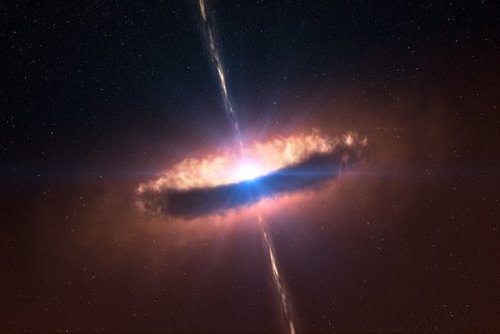



What is a protostar?
The formation of stars begins with the collapse and fragmentation of molecular clouds into very dense clumps. These clumps initially contain ~0.01 solar masses of material, but increase in mass as surrounding material is accumulated through accretion. The temperature of the material also increases while the area over which it is spread decreases as gravitational contraction continues, forming a more stellar-like object in the process. During this time, and up until hydrogen burning begins and it joins the main sequence, the object is known as a protostar.
This stage of stellar evolution may last for between 100,000 and 10 million years depending on the size of the star being formed. If the final result is a protostar with more than 0.08 solar masses, it will go on to begin hydrogen burning and will join the main sequence as a normal star. For protostars with masses less than this, temperatures are not sufficient for hydrogen burning to begin and they become brown dwarf stars.
Protostars are enshrouded in gas and dust and are not detectable at visible wavelengths. To study this very early stage of stellar evolution, astronomers must use infrared or microwave wavelengths.
Protostars are also known as Young Stellar Objects (YSOs).









💌
It’s been a really long time since I came on tumblr, but I started thinking a bit about how difficult year 13 was for me and what I could have done differently. they’re lengthy but there’s a lot to be said!!
These are some things that helped me when I was studying with depression - I have to say these don’t always help, and nothing will replace getting medical help. These just helped me take each day as it came, so I hope they’re of some use!
Please, please, please think of your health and really take care of yourself whilst studying and even more so in exam season.
⭐️⭐️⭐️⭐️ lots of love






some memes I made to express my current frustrations with academia feel free to add your own

Central Cygnus Skyscape via NASA https://ift.tt/2vgpcsn

Melotte 15, Inside the Heart
why is mercury shrinking?
Unlike the Earth, Mercury’s surface is made up of just one continental plate covering the entire planet, as Mercury’s interior is slowly cooling it also shrinks and the total volume of mercury shrinks.




I did some drawings on my ipad using the goodnotes app and referencing google images.
Why Won’t Our Parker Solar Probe Melt?
This summer, our Parker Solar Probe will launch to travel closer to the Sun than any mission before it, right into the Sun’s outer atmosphere, the corona.

The environment in the corona is unimaginably hot: The spacecraft will travel through material with temperatures greater than 3 million degrees Fahrenheit.
So…why won’t it melt?
The Difference Between Heat and Temperature
Parker Solar Probe was designed from the ground up to keep its instruments safe and cool, but the nature of the corona itself also helps. The key lies in the difference between heat and temperature.
Temperature measures how fast particles are moving, while heat is the total amount of energy that they transfer. The corona is an incredibly thin and tenuous part of the Sun, and there are very few particles there to transfer energy – so while the particles are moving fast (high temperature), they don’t actually transfer much energy to the spacecraft (low heat).

It’s like the difference between putting your hand in a hot oven versus putting it in a pot of boiling water (don’t try this at home!). In the air of the oven, your hand doesn’t get nearly as hot as it would in the much denser water of the boiling pot.
So even though Parker Solar Probe travels through a region with temperatures of several million degrees, the surface of its heat shield will reach only about 2,500 F.

The Heat Shield
Of course, thousands of degrees Fahrenheit is still way too hot for scientific instruments. (For comparison, lava from volcano eruptions can be anywhere between 1,300 to 2,200 F.)
To withstand that heat, Parker Solar Probe is outfitted with a cutting-edge heat shield, called the Thermal Protection System. This heat shield is made of a carbon composite foam sandwiched between two carbon plates. The Sun-facing side is covered with a specially-developed white ceramic coating, applied as a plasma spray, to reflect as much heat as possible.

The heat shield is so good at its job that even though the Sun-facing side of the shield will be at 2,500 F, the instruments in its shadow will remain at a balmy 85 F.
Parker Solar Probe Keeps its Cool
Several other designs on the spacecraft help Parker Solar Probe beat the heat.
Parker Solar Probe is not only studying the Sun – it’s also powered by it. But even though most of the surface area of its solar arrays can be retracted behind the heat shield, even that small exposed segment would quickly make them overheat while at the Sun.

To keep things cool, Parker Solar Probe circulates a single gallon of water through its solar arrays. The water absorbs heat as it passes behind the arrays, then radiates that heat out into space as it flows into the spacecraft’s radiator.
It’s also important for Parker Solar Probe to be able to think on its feet, since it takes about eight minutes for information to travel between Earth and the Sun. If we had to control the spacecraft from Earth, by the time we knew something went wrong, it would be too late to fix it.
So Parker Solar Probe is smart: Along the edges of the heat shield’s shadow are seven sensors. If any of these sensors detect sunlight, they alert the central computer and the spacecraft can correct its position to keep the sensors – and the rest of the instruments – safely protected behind the heat shield.

Over the course of its seven-year mission, Parker Solar Probe will make 24 orbits of our star. On each close approach to the Sun, it will sample the solar wind, study the Sun’s corona, and provide unprecedentedly close up observations from around our star – and armed with its slew of innovative technologies, we know it will keep its cool the whole time.
Parker Solar Probe launches summer 2018 on its mission to study the Sun. Keep up with the latest on the mission at nasa.gov/solarprobe or follow us on Twitter and Facebook.
Make sure to follow us on Tumblr for your regular dose of space: http://nasa.tumblr.com
Dust, stars, and cosmic rays swirling around Comet 67P/Churyumov–Gerasimenko, captured by the Rosetta probe. (Source)
What is a Wormhole?
Wormholes were first theorized in 1916, though that wasn’t what they were called at the time. While reviewing another physicist’s solution to the equations in Albert Einstein’s theory of general relativity, Austrian physicist Ludwig Flamm realized another solution was possible. He described a “white hole,” a theoretical time reversal of a black hole. Entrances to both black and white holes could be connected by a space-time conduit.

In 1935, Einstein and physicist Nathan Rosen used the theory of general relativity to elaborate on the idea, proposing the existence of “bridges” through space-time. These bridges connect two different points in space-time, theoretically creating a shortcut that could reduce travel time and distance. The shortcuts came to be called Einstein-Rosen bridges, or wormholes.

Certain solutions of general relativity allow for the existence of wormholes where the mouth of each is a black hole. However, a naturally occurring black hole, formed by the collapse of a dying star, does not by itself create a wormhole.
Wormholes are consistent with the general theory of relativity, but whether wormholes actually exist remains to be seen.

A wormhole could connect extremely long distances such as a billion light years or more, short distances such as a few meters, different universes, or different points in time
For a simplified notion of a wormhole, space can be visualized as a two-dimensional (2D) surface. In this case, a wormhole would appear as a hole in that surface, lead into a 3D tube (the inside surface of a cylinder), then re-emerge at another location on the 2D surface with a hole similar to the entrance. An actual wormhole would be analogous to this, but with the spatial dimensions raised by one. For example, instead of circular holes on a 2D plane, the entry and exit points could be visualized as spheres in 3D space.

Science fiction is filled with tales of traveling through wormholes. But the reality of such travel is more complicated, and not just because we’ve yet to spot one.

The first problem is size. Primordial wormholes are predicted to exist on microscopic levels, about 10–33 centimeters. However, as the universe expands, it is possible that some may have been stretched to larger sizes.
Another problem comes from stability. The predicted Einstein-Rosen wormholes would be useless for travel because they collapse quickly.

“You would need some very exotic type of matter in order to stabilize a wormhole,” said Hsu, “and it’s not clear whether such matter exists in the universe.”
But more recent research found that a wormhole containing “exotic” matter could stay open and unchanging for longer periods of time.

Exotic matter, which should not be confused with dark matter or antimatter, contains negative energy density and a large negative pressure. Such matter has only been seen in the behavior of certain vacuum states as part of quantum field theory.
If a wormhole contained sufficient exotic matter, whether naturally occurring or artificially added, it could theoretically be used as a method of sending information or travelers through space. Unfortunately, human journeys through the space tunnels may be challenging.

Wormholes may not only connect two separate regions within the universe, they could also connect two different universes. Similarly, some scientists have conjectured that if one mouth of a wormhole is moved in a specific manner, it could allow for time travel.

Although adding exotic matter to a wormhole might stabilize it to the point that human passengers could travel safely through it, there is still the possibility that the addition of “regular” matter would be sufficient to destabilize the portal.
Today’s technology is insufficient to enlarge or stabilize wormholes, even if they could be found. However, scientists continue to explore the concept as a method of space travel with the hope that technology will eventually be able to utilize them.
source
source
images: x, x, x, x, x, x, x, x, x
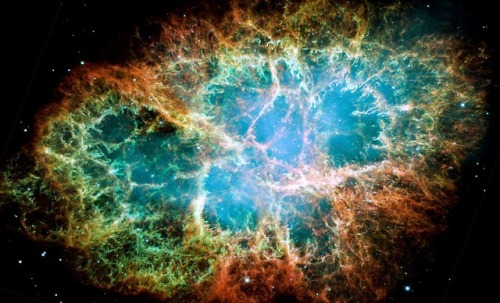
The Crab Pulsar (PSR B0531+21) is a relatively young neutron star. The star is the central star in the Crab Nebula, a remnant of the supernova SN 1054, which was widely observed on Earth in the year 1054. Discovered in 1968, the pulsar was the first to be connected with a supernova remnant.

The Crab Pulsar is one of very few pulsars to be identified optically. The optical pulsar is roughly 20 kilometres (12 mi) in diameter and the pulsar “beams” rotate once every 33 milliseconds, or 30 times each second.

The outflowing relativistic wind from the neutron star generates synchrotron emission, which produces the bulk of the emission from the nebula, seen from radio wavesthrough to gamma rays. The most dynamic feature in the inner part of the nebula is the point where the pulsar’s equatorial wind slams into the surrounding nebula, forming a termination shock.

The shape and position of this feature shifts rapidly, with the equatorial wind appearing as a series of wisp-like features that steepen, brighten, then fade as they move away from the pulsar into the main body of the nebula. The period of the pulsar’s rotation is slowing by 38 nanoseconds per day due to the large amounts of energy carried away in the pulsar wind.

The Crab Nebula is often used as a calibration source in X-ray astronomy. It is very bright in X-rays and the flux density and spectrum are known to be constant, with the exception of the pulsar itself.
source | A History of the Crab Nebula
images: NASA/ESA, Hubble, Cambridge University Lucky Imaging Group, NASA/CXC/ASU/J.Hester et al.

The NASA/ESA Hubble Space Telescope captures the iridescent tapestry of star birth in a neighbouring galaxy in this panoramic view of glowing gas, dark dust clouds, and young, hot stars.
Credit: NASA/ESA and the Hubble Heritage Team (AURA/STScI/HEIC)




Hayabusa2: Wide-angle navigational images of asteroid Ryugu, taken today as the probe descended temporarily to just 5km from the asteroid’s surface. These were originally posted to the probe’s Twitter feed.

Bow Tie Moon and Star Trails : On January 31, a leisurely lunar eclipse was enjoyed from all over the night side of planet Earth, the first of three consecutive total eclipses of the Moon. This dramatic time-lapse image followed the celestial performance for over three hours in a combined series of exposures from Hebei Province in Northern China. Fixed to a tripod, the camera records the Full Moon sliding through a clear night sky. Too bright just before and after the eclipse, the Moon’s bow tie-shaped trail grows narrow and red during the darker total eclipse phase that lasted an hour and 16 minutes. In the distant background are the colorful trails of stars in concentric arcs above and below the celestial equator. via NASA

Venus and the Triply Ultraviolet Sun : An unusual type of solar eclipse occurred in 2012. Usually it is the Earth’s Moon that eclipses the Sun. That year, most unusually, the planet Venus took a turn. Like a solar eclipse by the Moon, the phase of Venus became a continually thinner crescent as Venus became increasingly better aligned with the Sun. Eventually the alignment became perfect and the phase of Venus dropped to zero. The dark spot of Venus crossed our parent star. The situation could technically be labeled a Venusian annular eclipse with an extraordinarily large ring of fire. Pictured here during the occultation, the Sun was imaged in three colors of ultraviolet light by the Earth-orbiting Solar Dynamics Observatory, with the dark region toward the right corresponding to a coronal hole. Hours later, as Venus continued in its orbit, a slight crescent phase appeared again. The next Venusian transit across the Sun will occur in 2117. via NASA
This is so important. I have two years left of my Bachelor degree, and it took me 16 years to get my associate. Never give up, even if you have to put those goals on hold (sometimes multiple times), because life happens. Make yours worth it.
just because someone’s accomplishing more than you are right now doesn’t mean you’re failing. success isn’t a race
Omg I’m dying
my favorite thing about the spanish harry potter translation is that instead of calling voldemort “the dark lord,” they call him señor tenebroso, which basically means “mr. spooky”
Maybe we shouldn’t have given Pluto unrealistic expectations of reality. 🤷🏻♀️
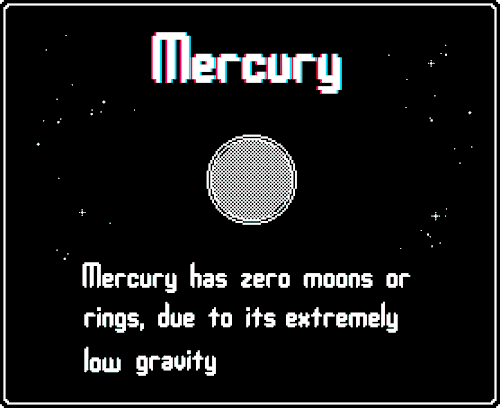
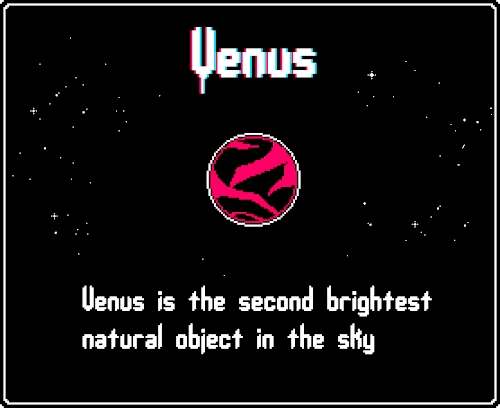




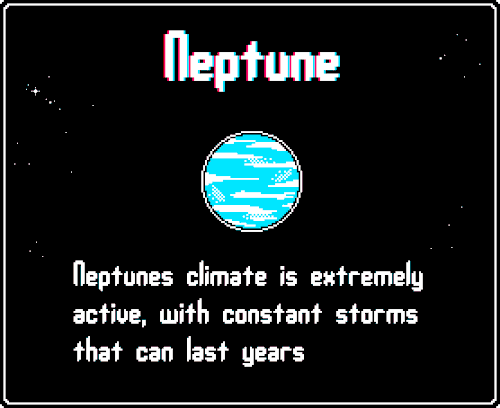

a gifset of planet facts because i rlly love space!!
//please dont remove caption!
I’ll never tell 🤭
space edition - tag yourself
moonlight: sleep deprived af, genius ideas at 2:00 am, constantly underestimated, tangled earbuds, pretends like they don’t care but actually cares a lot, unscented candles
comet: will fight you for their friends, perfect eyeliner, doesn’t get angry but instead just fucking glares at you until you crumble, loves thunderstorms, cat person
stars: has no idea what they’re doing 167% of the time, artsy, likes halsey, string lights everywhere, loves fuzzy socks and blankets, probably wears space buns
alien: secretly is super good at makeup but doesn’t wear it often, lots of coffee, probably has a pet fish, reads young adult fantasy novels, closet conspiracy theorist, arms and papers always covered in doodles
black hole: 97% of their wardrobe is hoodies, professional procrastinator, can write, probably owns essential oils, eats ramen at 1:00 am, only writes in pen, actually really cool but doesn’t know it
spacedust: bath bombs, a+ insta feed, long flowy skirts and tops, city person, pretends to have their shit together, secretly loves kermit memes, probably dyed their hair at one point

NASA’s Fermi Traces Source of Cosmic Neutrino to Monster Black Hole
NASA - Fermi Gamma-ray Space Telescope logo. July 12, 2018 For the first time ever, scientists using NASA’s Fermi Gamma-ray Space Telescope have found the source of a high-energy neutrino from outside our galaxy. This neutrino traveled 3.7 billion years at almost the speed of light before being detected on Earth. This is farther than any other neutrino whose origin scientists can identify. High-energy neutrinos are hard-to-catch particles that scientists think are created by the most powerful events in the cosmos, such as galaxy mergers and material falling onto supermassive black holes. They travel at speeds just shy of the speed of light and rarely interact with other matter, allowing them to travel unimpeded across distances of billions of light-years.
Image above: NASA’s Fermi (top left) has achieved a new first—identifying a monster black hole in a far-off galaxy as the source of a high-energy neutrino seen by the IceCube Neutrino Observatory (sensor strings, bottom). Image Credits: NASA/Fermi and Aurore Simonnet, Sonoma State University. The neutrino was discovered by an international team of scientists using the National Science Foundation’s IceCube Neutrino Observatory at the Amundsen–Scott South Pole Station. Fermi found the source of the neutrino by tracing its path back to a blast of gamma-ray light from a distant supermassive black hole in the constellation Orion. “Again, Fermi has helped make another giant leap in a growing field we call multimessenger astronomy,” said Paul Hertz, director of the Astrophysics Division at NASA Headquarters in Washington. “Neutrinos and gravitational waves deliver new kinds of information about the most extreme environments in the universe. But to best understand what they’re telling us, we need to connect them to the ‘messenger’ astronomers know best—light.” Scientists study neutrinos, as well as cosmic rays and gamma rays, to understand what is going on in turbulent cosmic environments such as supernovas, black holes and stars. Neutrinos show the complex processes that occur inside the environment, and cosmic rays show the force and speed of violent activity. But, scientists rely on gamma rays, the most energetic form of light, to brightly flag what cosmic source is producing these neutrinos and cosmic rays. “The most extreme cosmic explosions produce gravitational waves, and the most extreme cosmic accelerators produce high-energy neutrinos and cosmic rays,” says Regina Caputo of NASA’s Goddard Space Flight Center in Greenbelt, Maryland, the analysis coordinator for the Fermi Large Area Telescope Collaboration. “Through Fermi, gamma rays are providing a bridge to each of these new cosmic signals.” The discovery is the subject of two papers published Thursday in the journal Science. The source identification paper also includes important follow-up observations by the Major Atmospheric Gamma Imaging Cherenkov Telescopes and additional data from NASA’s Neil Gehrels Swift Observatory and many other facilities.
Image above: The discovery of a high-energy neutrino on September 22, 2017, sent astronomers on a chase to locate its source—a supermassive black hole in a distant galaxy. Image Credits: NASA’s Goddard Space Flight Center. On Sept. 22, 2017, scientists using IceCube detected signs of a neutrino striking the Antarctic ice with energy of about 300 trillion electron volts—more than 45 times the energy achievable in the most powerful particle accelerator on Earth. This high energy strongly suggested that the neutrino had to be from beyond our solar system. Backtracking the path through IceCube indicated where in the sky the neutrino came from, and automated alerts notified astronomers around the globe to search this region for flares or outbursts that could be associated with the event. Data from Fermi’s Large Area Telescope revealed enhanced gamma-ray emission from a well-known active galaxy at the time the neutrino arrived. This is a type of active galaxy called a blazar, with a supermassive black hole with millions to billions of times the Sun’s mass that blasts jets of particles outward in opposite directions at nearly the speed of light. Blazars are especially bright and active because one of these jets happens to point almost directly toward Earth.
Image above: Fermi-detected gamma rays from TXS 0506+056 are shown as expanding circles. Their maximum size, color—from white (low) to magenta (high)—and associated tone indicate the energy of each ray. Image Credits: NASA/DOE/Fermi LAT Collab. Fermi scientist Yasuyuki Tanaka at Hiroshima University in Japan was the first to associate the neutrino event with the blazar designated TXS 0506+056 (TXS 0506 for short). “Fermi’s LAT monitors the entire sky in gamma rays and keeps tabs on the activity of some 2,000 blazars, yet TXS 0506 really stood out,” said Sara Buson, a NASA Postdoctoral Fellow at Goddard who performed the data analysis with Anna Franckowiak, a scientist at the Deutsches Elektronen-Synchrotron research center in Zeuthen, Germany. “This blazar is located near the center of the sky position determined by IceCube and, at the time of the neutrino detection, was the most active Fermi had seen it in a decade.”
Visualizing Gamma Rays From Blazar TXS 0506+056
Video above: Fermi-detected gamma rays from TXS 0506+056 are shown as expanding circles. Their maximum size, color—from white (low) to magenta (high)—and associated tone indicate the energy of each ray. The first sequence shows typical emission; the second shows the 2017 flare leading to the neutrino detection. Video Credits: NASA/DOE/Fermi LAT Collab., Matt Russo and Andrew Santaguida/SYSTEM Sounds. NASA’s Fermi Gamma-ray Space Telescope is an astrophysics and particle physics partnership, developed in collaboration with the U.S. Department of Energy and with important contributions from academic institutions and partners in France, Germany, Italy, Japan, Sweden and the United States. The NASA Postdoctoral Fellow program is administered by Universities Space Research Association under contract with NASA. For more about NASA’s Fermi mission, visit: https://www.nasa.gov/fermi Fermi Gamma-Ray Space Telescope: http://www.nasa.gov/mission_pages/GLAST/main/index.html Related links: The source identification paper: http://science.sciencemag.org/cgi/doi/10.1126/science.aat1378 Major Atmospheric Gamma Imaging Cherenkov Telescopes: https://magic.mpp.mpg.de/ NASA’s Neil Gehrels Swift Observatory: https://www.nasa.gov/mission_pages/swift/main Deutsches Elektronen-Synchrotron: http://www.desy.de/index_eng.html Images (mentioned), Video (mentioned), Text, Credits: NASA/Felicia Chou/Sean Potter/GSFC/Dewayne Washington. Greetings, Orbiter.ch Full article


❤️

Female Physicist’s moodboard <3
i feel bad for math. its such a calm and friendly discipline full of beautiful and complex patterns and theres absolutely nothing inherently bad or oppressive about it but ppl treat it as though its evil and malicious. a lot of pure math lacks any kind of practical application or end goal, and just exists for the sake of stimulating peoples minds and pushing the limits of the medium as far as is possible. much like almost every kind of art
math means u no harm friends
But not just my body... my mind, my heart.
I hope the next thing I get addicted to is taking care of my self and loving my body
